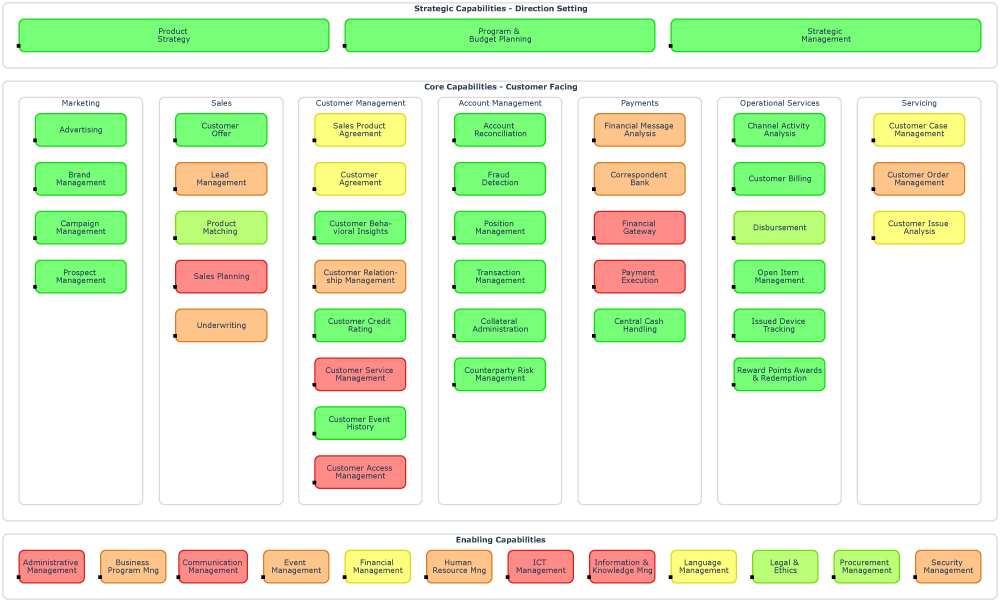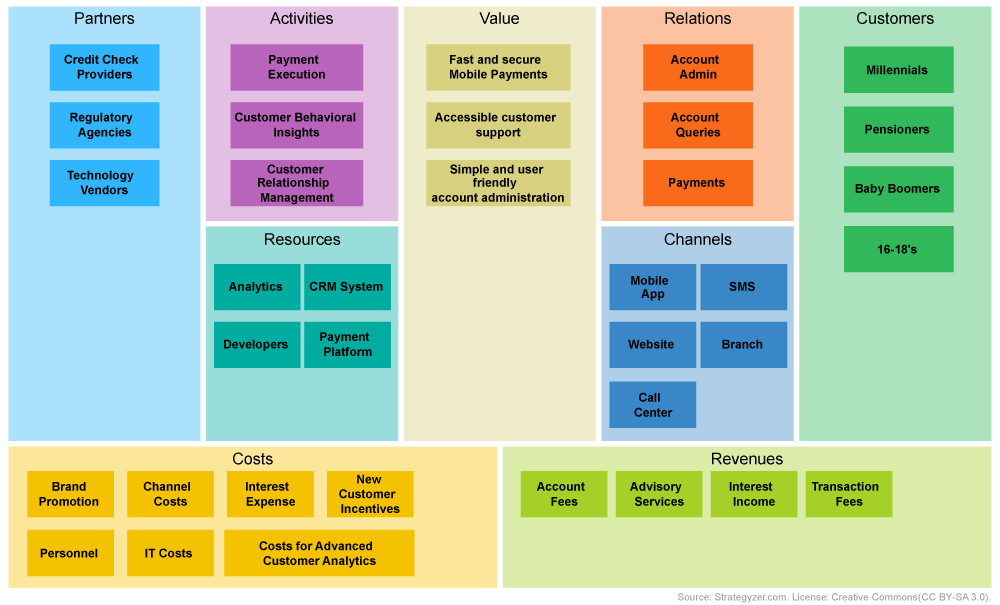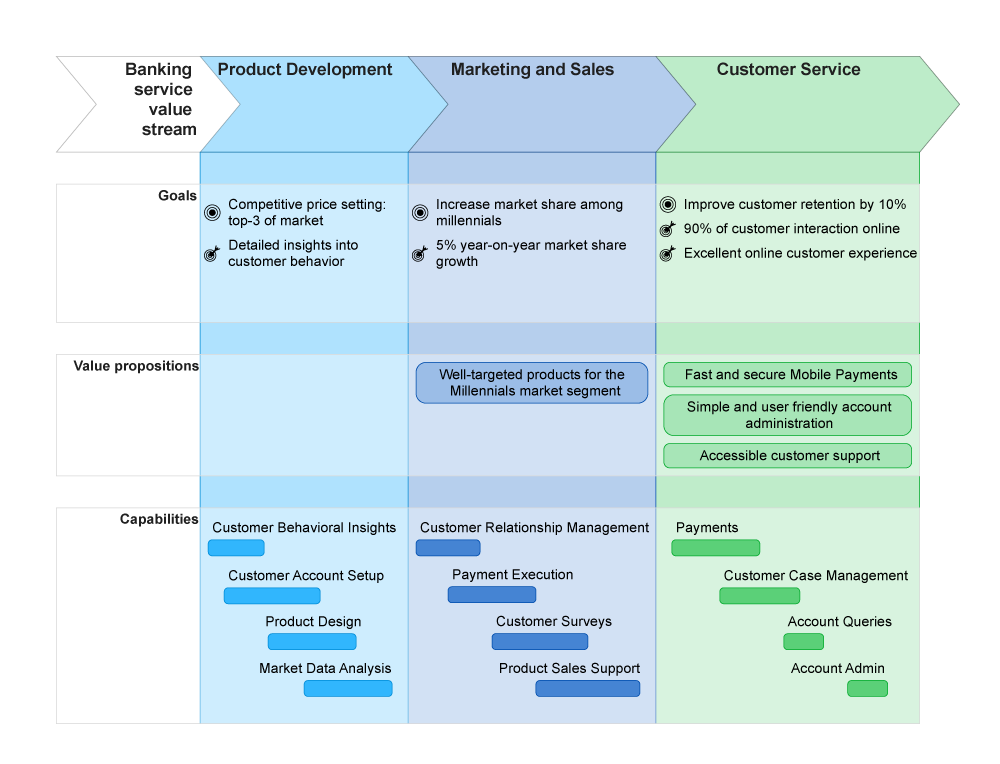Relating Capabilities to Strategy and Business Model

In our ongoing blog series on Capabilities and Capability-based Planning, we’ve mainly concentrated on the capability concept itself. We’ve discussed why capabilities are useful as a concept, how to define them, and how to structure Capability Maps. We’ve also looked at how you can use Capability Maps to support business challenges such as investment decision-making, to name a few.
In this blog, we want to cast a wider net and look at the relationships between capabilities, and share best practices for your business and strategic planning.
Relating Business Strategy and Capabilities
The relationship between business strategy and capabilities is a two-way street. On the one hand, the strategy of an enterprise is a way of configuring its capabilities and resources to achieve certain goals. This may entail improving some capabilities, developing or acquiring completely new ones, or even divesting some non-core, non-strategic capabilities.
On the other hand, your existing capabilities may lead you to pursue entirely new ventures. As several manufacturing companies learned at the start of the Covid pandemic, their existing capabilities allowed them to shift focus to the production of personal protective equipment or even more specialized products like ventilators.
This is exactly what Demcon did, the company next door to Bizzdesign’s head office in Enschede: They developed, produced, tested, and delivered complete ventilation systems within the space of one month, using their pre-existing capabilities in producing related technology.
Mapping the strategic relevance of your capabilities and combining this with information on cost and investment, is a great way to support management decision making. Below, you can see an example based on views used by one of our customers.
The example shows with different colors the total IT cost for each capability (dark blue = high, light blue = low), calculated as a roll-up of the operational cost of existing systems (run) and the investment in new IT (change).
This cost is distributed across the capabilities according to the use the customer makes of these systems. Line width depicts the strategic importance of each capability, which is calculated as a weighted average of a capability’s relevance in terms of the company’s 5 strategic, long-term goals.
The company’s program portfolio board uses these heat maps in IT investment planning. In the figure, you can see that most of the IT investment goes towards Sales, Customer Management, and Payment, which include some highly strategic sub-capabilities such as Payment Execution.
You can also see strategically important capabilities with low IT investment levels, e.g. Customer Bulling, possibly because these are not IT-intensive but maybe also because of a misallocation of budgets. Conversely, some capabilities receive substantial investment, e.g. Communication Management, without being very strategic to the company. Does your strategic management have this insight without capability-based investment planning?

Figure 1. A capability heat map with IT investment levels (color) vs. strategic importance (label)
From Business Model to Capabilities
You may be familiar with the Business Model Canvas, which is a great way to depict the business model of an enterprise. Within this structure (see the figure below), there’s a box called “(Key) Activities”.
Rather than describing operational activities here, we would use this to list the key capabilities needed for this business model. In the example below, we focus on a specific aspect of the business model of our example company, concerning a customer-centric banking application.

Figure 2. Business Model Canvas
Reusing the same capabilities in the Business Model Canvas is a great example of how you can connect different best practices for business analysis and architecture. You can even highlight in the canvas the strategic and investment analysis we have described earlier. That would show, for instance, that the strategic importance and investment level of Payment Execution match its role in this business model.
From Capabilities to Resources
For the “Asset Management” capability mentioned above, an insurance company needs personnel with the right skills, information on the financial markets. Perhaps even high-speed transactional systems, and much more. Of course, you want to define a capability in an implementation-neutral manner, but without such an implementation you don’t have that capability.
Moreover, resources often have a strategic value by themselves: for example, in a copper mining company, the copper mine will be paramount in your strategy. You won’t think about your company in terms of an abstract “Ore Extraction” capability but in terms of how you extract ore from this specific mine with all its geological and other peculiarities.
At the same time, you don’t want to lose yourself in all the details of an operating model, when you’re working on your strategies. Therefore, the ArchiMate language provides the concept ‘Resource’ (defined as any asset that is owned or controlled by an individual or organization), which allows you to do strategy planning at a higher level. See also our blog on ArchiMate 3.0 – Capability Realization as an example.
Relating Capabilities and Value Streams
Where capabilities represent the enterprise “at rest”, i.e., its abilities and potential, value streams describe the enterprise “in motion” (e.g. sequences of activities to create value for customers, stakeholders, and others).
These two concepts are like potential and kinetic energy in physics, they’re two sides of the same coin. To describe their relationship, cross-mapping can be done between capabilities and value streams.
This shows how capabilities will support the stages in a value stream. This can be done at a very high level, where you capture the entire value chain of the enterprise.
The stages in this value chain can be cross-mapped to the top-level capabilities in the Capability Map. At a more detailed level, a value stream captures how a specific result of value is created for a specific stakeholder or group (e.g. a customer segment).
The stages of such a more detailed value stream are in turn supported by capabilities from a more detailed level of your Capability Map. One way to represent this is in the form of a Business Outcome Journey Map. This is similar to a Customer Journey Map but at a higher level.
Rather than describing the specific steps that an individual customer takes (with all the possible exceptions and variants), it shows the stages in a value stream, the goals and value propositions of each stage, and the capabilities supporting it.
READ: Business Capabilities Guide
This can link back to your investment planning or Business Model Canvas mentioned above, where you also find these value propositions, for instance. An ArchiMate Model provides great value in the backend, as it captures the concepts and relationships of both the Business Model Canvas and the Capability Map, tying everything together.

Figure 3. Business Outcome Journey Map
Where to Start?
In this blog, we’ve demonstrated best practices to analyze and get new insights on why you (should) invest in specific capabilities. We’ve also looked at how you can provide more context information with Business Model Canvas, resources and value stream views for your strategic and business planning. In the next installment in this series, we will address how capabilities are realized by the operating model of the enterprise. Stay tuned!
Summary
Relating capabilities to strategy and business models enables organizations to move from abstract planning to actionable insights. By aligning capabilities with resources, value streams, and investment priorities, enterprises can ensure that strategy translates into measurable outcomes. This integrated perspective allows business architects to better guide transformation initiatives, support decision-making, and create long-term business value.
FAQs
Business strategy configures capabilities and resources to achieve goals, while existing capabilities can open opportunities for new ventures.
The Business Model Canvas highlights key capabilities needed for value creation, making strategy and investment planning more concrete.
Capabilities represent potential, while value streams represent value creation in motion. Cross-mapping them shows how capabilities support each stage of value delivery.



